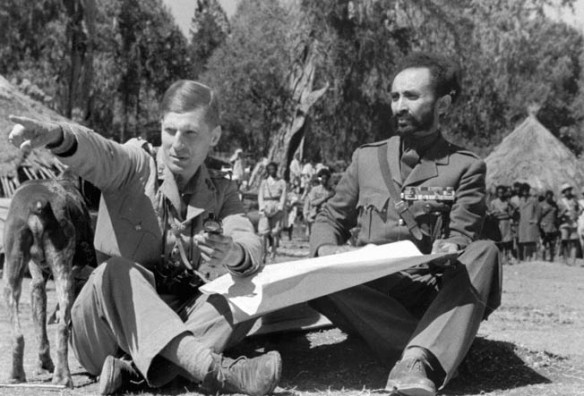Haile Selassie, Emperor of Abyssinia, was exiled by Mussolini in 1936 after the Italian occupation of his country. In May 1941 he was escorted back to his capital, Addis Ababa, and to his throne by Colonel Orde Wingate (left) following a daring guerrilla campaign. His was the first country to be liberated from Axis control but he failed to ensure its independence and was deposed in 1974.
In East Africa Italian forces under the command of the Duke of Aosta had captured outposts in Sudan and Kenya and occupied British Somaliland soon after Italy had entered the war. Although they vastly outnumbered the British forces, most of whom had been raised locally, Aosta was demoralized by the Italian defeats in the Western Desert and at the moment of Britain’s greatest weakness he unwisely adopted a defensive posture. The British had also broken the Italian Army and Air Force codes and, armed with copies of Italian orders as soon as they were issued, Major General William Platt launched an offensive into Eritrea on 19 January 1941 with 4th and 5th Indian Divisions. After weeks of hard fighting they captured Keren on 27 March, which proved to be the decisive campaign of the battle, and entered Massawa on 8 April. Meanwhile, on 11 February, Lieutenant General Alan Cunningham launched an offensive into Italian Somaliland from Kenya using British East African and South African troops with startling success. After capturing Mogadishu, the capital of Italian Somaliland, on 25 February he struck north toward Harar in Abyssinia, which he captured on 26 March. A small force from Aden reoccupied British Somaliland without opposition on 16 March, to shorten the supply line, and joined with Cunningham’s force to capture Addis Ababa on 6 April. In just eight weeks Cunningham’s troops had advanced over 2,735 km (1,700 miles) and defeated the majority of Aosta’s troops for the loss of 501 casualties.
Even more spectacular were the achievements of Lieutenant-Colonel Orde Wingate, later to win fame as commander of the Chindits in Burma, who commanded a group of 1,600 local troops, known as the Patriots, whom he christened “Gideon force” Through a combination of brilliant guerrilla tactics, great daring and sheer bluff he defeated the Italian Army at Debra Markos and returned the Emperor Haile Selassie to his capital, Addis Ababa, on 5 May. British troops pressed Aosta’s forces into a diminishing mountainous retreat until he finally surrendered on 16 May, ending Italian resistance apart from two isolated pockets that were rounded up in November 1941.
The campaign in east Africa was important because the conquest of Ethiopia, Mussolini’s proudest achievement, had been undone and for the first time a country occupied by the Axis had been liberated. Another 230,000 Italian troops were captured and vital British forces were released for operations in the Western Desert. It was also the first campaign in which Ultra and the codebreakers at Bletchley Park played a decisive role, providing an invaluable lesson on the impact that intelligence could have on the outcome of an operation. Success in east Africa also had an important strategic consequence since President Roosevelt was able to declare on 11 April that the Red Sea and the Gulf of Aden were no longer war zones and US ships were thus able to deliver supplies direct to Suez, relieving the burden on British shipping.
